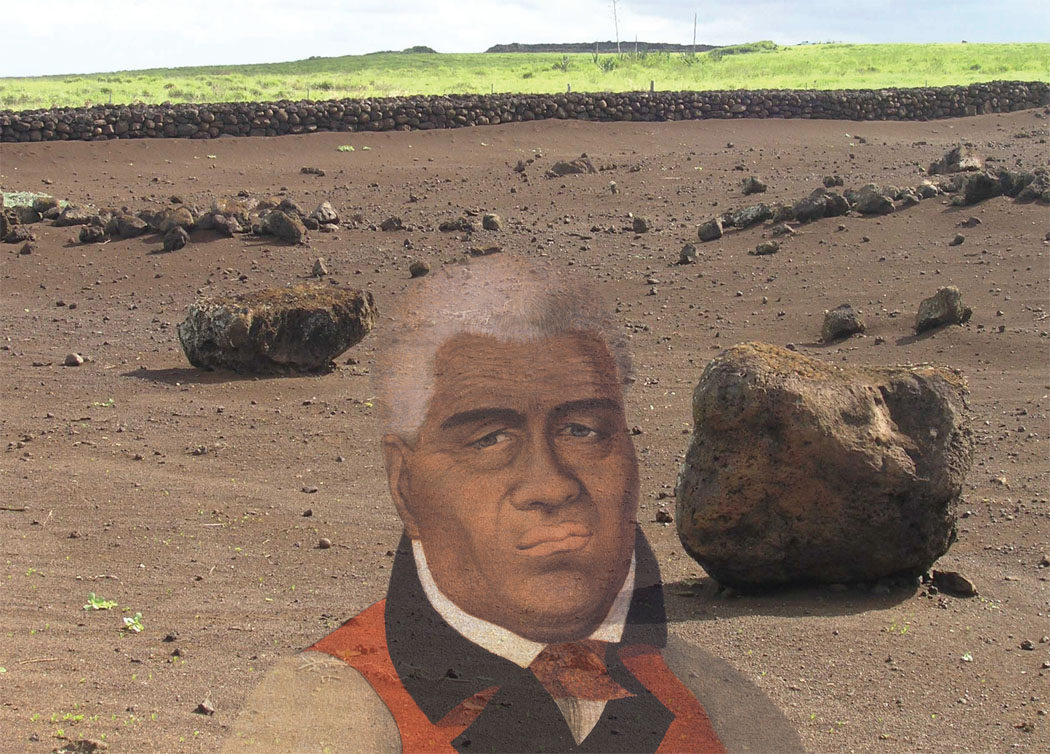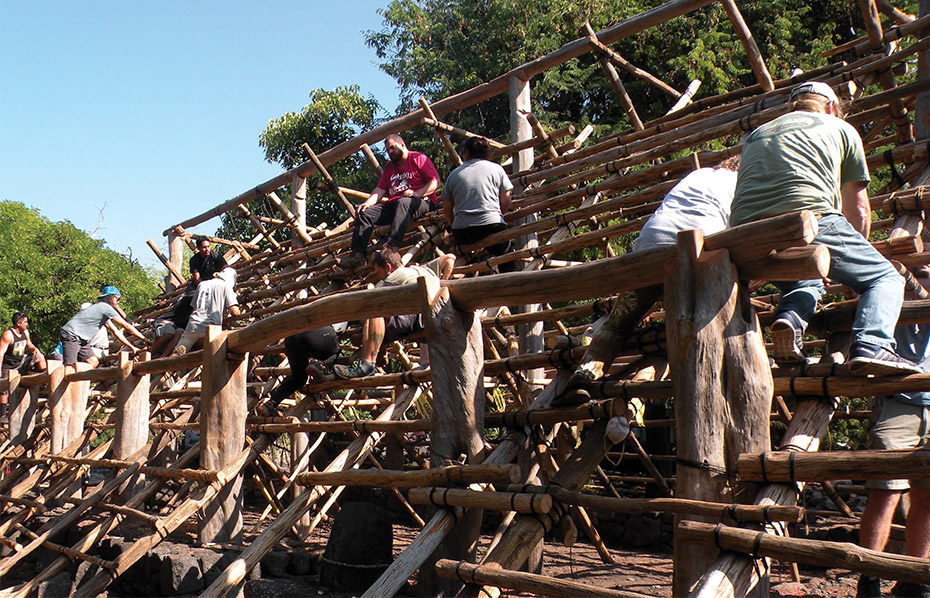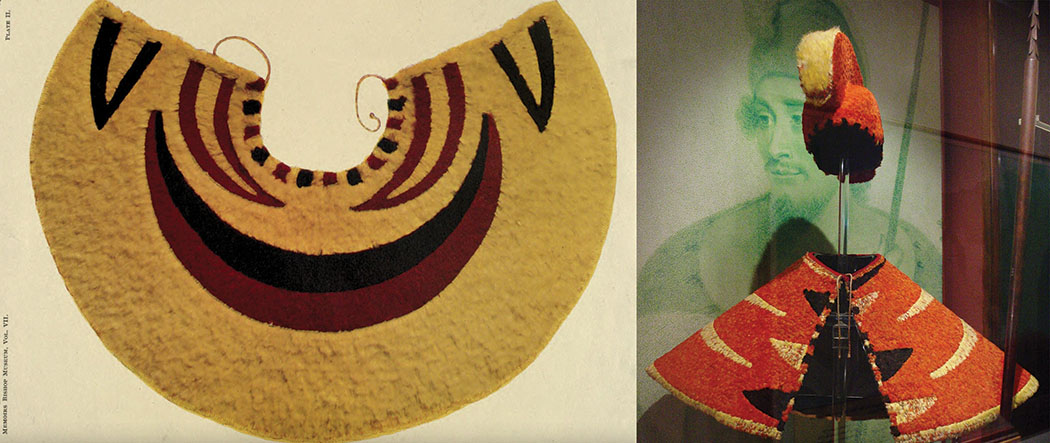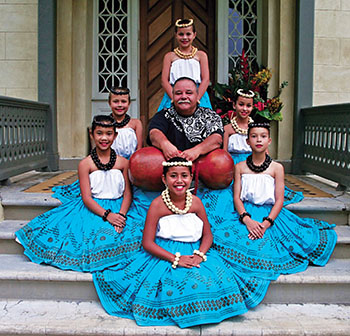
Kumu Hula Etua Lopes, E Ola E Ola Mau
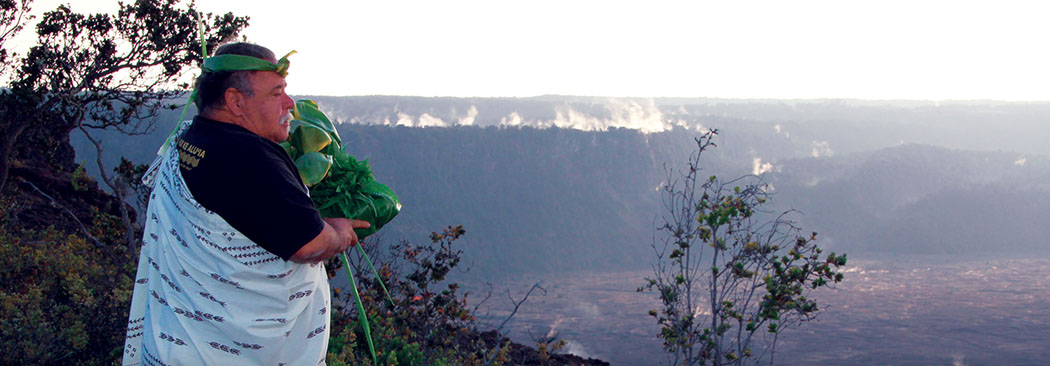
Kīlauea Volcano, 2013.
By Gayle ‘Kaleilehua’ Greco
When the moments in between chicken skin are filled with laughter or tears, you know you are in the presence of the great storyteller, Kumu Hula Etua Lopes. Born on August 29, 1953 in Damien Track on the outskirts of Honolulu, Edward (Etua Lopes) is the youngest of 10 siblings. The Lopes’ ‘ohana moved to Kāne‘ohe when Edward was three years old and lived in a quonset hut beside acres of ginger and fruit trees.
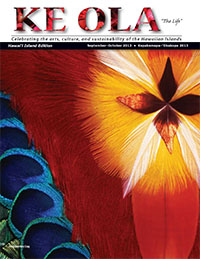
It seemed like the idyllic life of a local country boy until you hear Uncle Buzzy Histo (Kumu Etua’s nephew) energetically exclaim, that Edward “was not too happy when I came along!” Etua being the youngest of the Lopes’ siblings made him the uncle closest in age to the next generation of nieces and nephews. Buzzy, six years younger than Etua, laughs at how they played tug-of-war over being the youngest and their antics at the apron strings of Virginia Lopes, Etua’s mother and Buzzy’s grandmother.
Buzzy says, “Edward could never do wrong in anyone’s eyes.” Of course, that doesn’t mean he didn’t try.
Etua relays a story from his childhood about his fervent dislike of liver. “If you weren’t at the table for dinner, you missed that meal of the day.” His eyes glisten and sparkle, giving way to laughter.
Etua recounts how he could pick out every meal that his mother prepared just by a whiff of her cooking. Perched high above the kitchen, clinging to the water pipe, Etua’s body shivered as the smell of simmering liver wafted up through the kitchen window. Scurrying back down the pipe, he ran into the fields and gathered fresh fruit and hid under the front porch steps while his mother called him to dinner. His sisters cleaned up after the meal and Etua was sent to his room for missing dinner. Licking his fingers all the way, with a belly full of fresh fruit, this little boy had won over the liver. He says his mother never knew, however a mother’s eyes and heart always know, and it is perhaps her true love of her youngest son that let him play this game without him ever knowing her wisdom.
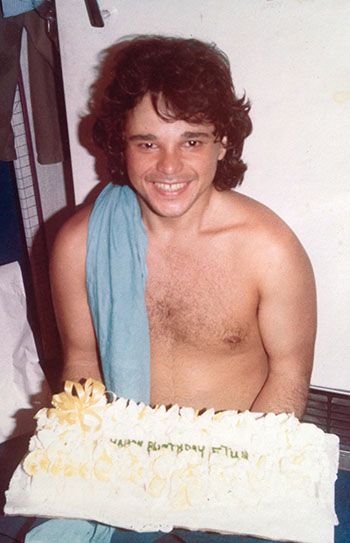
Best friends and hula brothers, Etua and Ray Fonseca spent their teenage years under the tutelage of Uncle George Na‘ope, Kumu Hula and iconic legend in the Hawaiian hula, music, and entertainment world. Etua and Ray began drumming in seventh grade when Ray asked Etua to be on a float in Honolulu’s 1966 King Kamehameha Day Parade. Ray was drumming and convinced Etua that he could too. Etua asked, “What do we wear?”—a classic question that remains at the forefront of Kumu Etua’s mind for every performance.
Etua’s mother sewed Aloha shirts for them, and off they went to their first official performance together. The cheering crowds sparked what would evolve into a long, close bond between these two young boys.
From this parade experience, Etua and Ray were asked to drum for the dance classes at the Nani Loa Hula Studio in Kāne‘ohe, managed by Aunty Pauline Patican and teacher, Aunty Lokelani Anderson, Aloha Deliere’s oldest sister. Etua reminisces, “They were so loving, we became their sons. We spent more time there than we did at home.”
On an eventful day at Nani Loa Hula Studio, Uncle George Na‘ope walked in to visit with Aunty’s Pauline and Lokelani. Uncle George said he wanted them to teach kahiko and bring the ancient hula back. He asked Lokelani if they had any Clorox® bottles. She had plenty. In a few short moments, Uncle George had the boys lined up with their imagined ipu out of plastic bleach bottles and began teaching kahiko to the boys. Uncle took Etua and Ray under his wing to elevate them to their next level. They practiced every day, every moment they could, and so did the dancers. Etua curiously and astutely watched every step and motion that Uncle was teaching the dancers. Knowing the dances himself, yet studying his own corrections of drumming, at age 16, this was hula: this was his life.
While Uncle George was the taskmaster, Aunty Pauline was, as Etua says, “My angel. She taught us so much about life and spirituality. She taught us to pray; we prayed all the time—before class, after class, on the way to a show, on the way back.” Etua continues, “She taught me the spirituality in the power of asking and receiving and thanking and completing that cycle. She reminded us continuously of this cycle—there is a Lord and He is the Creator.”
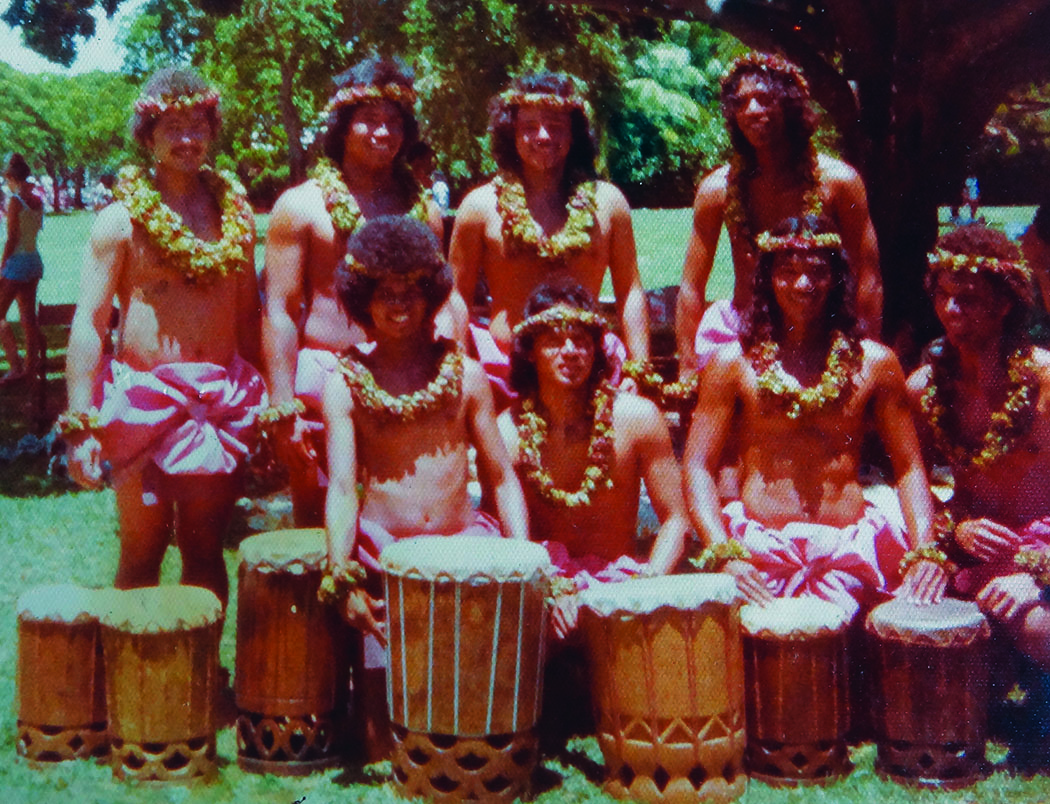
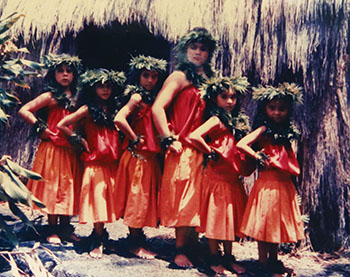
Kumu Etua’s first Keiki Hula class at Kahalu‘u Beach Park, circa 1980.
Years later, after performing in some of the top Polynesian shows in Waikīkī, Etua, Ray, and Uncle George returned to the Nani Loa Hula Studio in Kāne‘ohe. Etua and Ray became alaka‘i and Etua says, “Where I was once a student, I was now a teacher.”
The saying that hula is life, became literal for Etua. What he had been groomed for was now occurring. Hula was his job, paid or not. It was his kuleana (responsibility).
Etua and Ray heard of an audition for the famous Tavana. Uncle George took both young men to the audition and Etua’s heart sunk as he looked around the room at hundreds of young men waiting to audition. In the end, both Etua and Ray were hired and upon seeing their brilliance, Tavana asked Uncle George if he could give Edward his stage name. Uncle George said yes, and three days later, Tavana came back and announced that Edward had been changed to Etua. Tavana explained to Uncle George and Etua that the word Etua in Tahitian means second or two, and he thoughtfully recited that Etua was second only to Uncle George.

In 1978, Etua and Ray had their ‘uniki (formal graduation for kumu hula) by Uncle George. They made their own drums, mats, and costumes.
Uncle George sent the boys to study with many of the legendary Hawaiian masters of the time, learning traditional crafting and the arts of the hula, music, and culture. “Imagine,” says Etua, “Being so young and put in the hands of these masters.”
Even with the additional teachings, Etua says there was only one kumu for him and Ray; no matter where they were in their lives, they would do anything for Uncle George. Thirty years ago, Etua did everything from sleeping on the beach, to living in a small studio, while starting to teach hula to six keiki at Kahalu‘u Beach Park.
Aunty Fanny Au Hoy shares the story of when her mother, Lei Collins, saw Etua teaching at Kahulu‘u Beach Park and she exclaimed, “Do you know who your teacher is? Why are you teaching hula at a beach park?”
Kumu Etua explained that he had nowhere else to teach and Uncle always told him that if there are keiki who want to hula, you teach them. “It is not about the money,” says Etua. “It is about the love of hula and the keiki.”
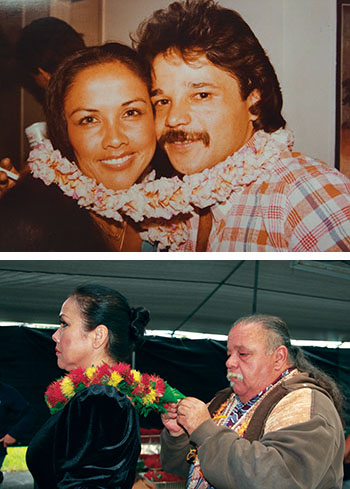
In a moment that would set the course for the next three decades and beyond, Aunty Lei invited Etua to bring his hula to the Hulihe‘e Palace. Kumu Etua glows with tear-filled joy about how a local boy was now sitting in the home of the ali‘i when all he ever did was read about it or peek in the door.
Soaking in all the mana‘o of that day, Etua was humbled to learn that Aunty Lei had talked with the Daughters of Hawai‘i, and from that day on, he was the kumu to hold classes at the Hulihe‘e Palace. He has not missed a performance or task; he gives back and pays forward everyday in recognition of the kuleana he has to the Palace. Kumu Etua says, “We have always done for the Palace here and in Honolulu. To this day, we still provide for both Palaces.” He continues, “You are chosen to dance on these grounds, and all the keiki at the Palace have learned their purpose here.”
Aunty Fannie remarks, “There are many dancers who say they dance at the Palace, however the only real Palace dancers are those of Kumu Etua’s hālau.”
One of Kumu Etua’s long-time dancers, Anita Okimoto, recounts moments under the instruction of Kumu Etua, where he would create the most intricate costumes, adornments, and hulas that were truly one-of-a-kind performances. She spoke with amazement of a Miss Kona Coffee Contest where Kumu created the opening number. He dressed his dancers in cellophane skirts and crinkly material. He put dark stripes on their face and made their hair bushy. “The dancers started running onto the stage and all you could hear was the clicking of the cellophane, just like crickets, click-clack-click.” Anita speaks through the laughter and continues, “We were the crickets on the coffee farm. Kumu Etua saw this; we never knew what it was going to be. No one sees what he sees, I’m sure of that.”
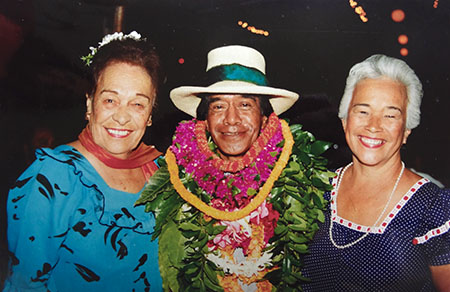
Anita says, “I want to tell Kumu this, thank you for teaching me. You gave me something that I didn’t know I needed in order to fulfill a part of my life that I am using today. Only because of you, I have the confidence and can do anything. Tell him,” she says with a smile that shines from her heart, “Tell him, I can finally see the colors. He will know what that means. It comes with commitment and dedication.”
Kumu Etua says, “The experience is about being quiet and learning, being humble, having respect for yourself, and understand how well you accept humility. Everything has to start with you. When you learn the mele, you see the evolution and how it repeats itself. You listen to the stories of the chants and relate it to your family and your life. Custom has changed but the initial kuleana is the same. Tradition is only what you behold at that time. Your tradition of today will be the tradition for tomorrow; it’s carried on. We want to teach what our kupuna taught us is tradition. Hula is everything. It is so well rounded and pertains to everything in life.”
While Kumu Etua and I were talking story at the Palace, a man walked up and said, “Etua?”
Kumu replied, “Yes.”
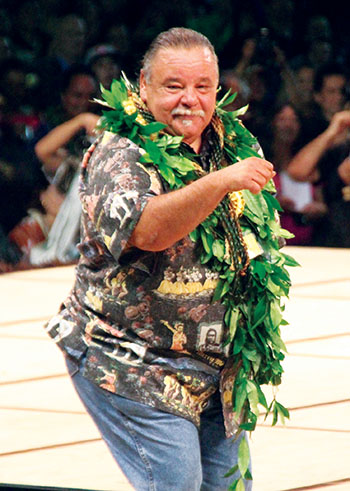
The man continued, “In 1987 my four-year-old daughter and I were visiting and you were teaching the children hula on the lawn here,” as he points to the back of the Palace. “My daughter asked me, “Can I go over and watch?” I said yes, and you graciously let her join the line. She was so inspired that when we got home, we enrolled her in hula classes, and today, 24 years later, she has won multiple national titles in Tahitian and hula. Your mana is so strong. I want to thank you for what you gave my daughter. Her life changed from the time she danced with you. Thank you.”
He shook Kumu’s hand and left, leaving behind an aura of silence filled with gratitude.
After a chicken-skin bath and blinking away tears, Kumu Etua emerged from his feelings and exclaimed, “Wow! And that is the reward; the reward of patience, humbleness, just everything. When I get rewarded like that, it is so good for me. Out of the blue someone will say, ‘I enjoy’ or ‘I have seen you’ and that is the reward. This is why I teach hula.” ❖
Photos courtesy Kumu Hula Etua Lopes, Suzi Derryberry
Contact Kumu Hula Etua Lopes at Hulihe‘e Palace: 808.329.9555
Contact writer Gayle ‘Kaleilehua’ Greco: gayle.greco@gmail.com
